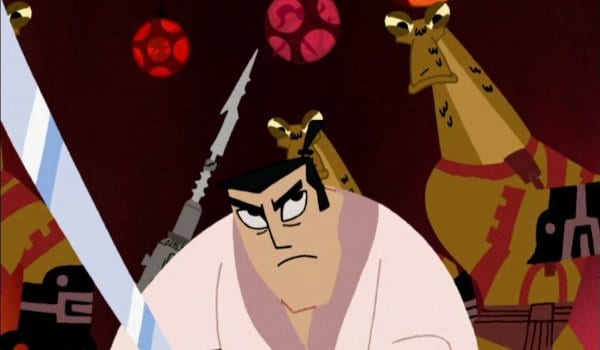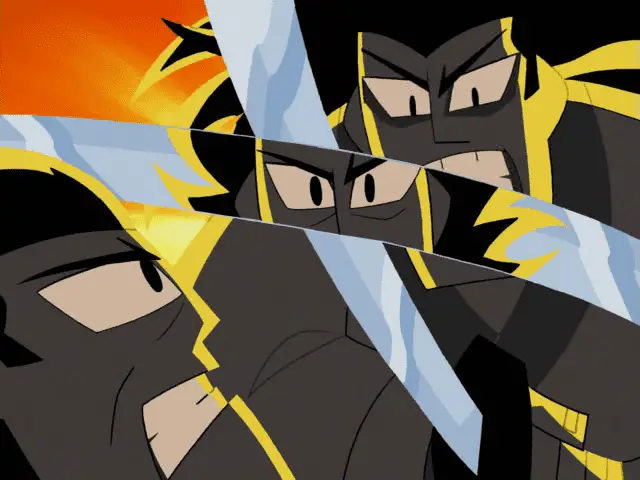For those who wish for closure, something so important to growth, it should be welcome news to all that Samurai Jack will finally have its final season come this March 11th. What is Samurai Jack, you say? Well, it’s a Cartoon Network show about a prince from feudal Japan who was sent forward in time by a demon named Aku before the prince could deal the killing blow. His quest over the first four seasons (airing 2001-2004) was to find a way back to the past and defeat Aku for good all while battling Aku’s robot minions with his magic Katana and meeting various immigrant alien races. It’s pretty dang awesome.
It’s also a really well crafted show. One that a single article couldn’t hope to sufficiently analyze. So, contributors Michal and Nick will tackle it in a three-part series that discusses the show’s Minimalism, Characters, and Themes. First on the chopping block: Minimalism.

For the purposes of this article, Minimalism refers to use of simplicity in a story, whether it be art, sound, or story design. It is when an art piece relished in the sparsity of its work while still communicating the information of its story. Something Minimalist often has all of the fat cut out, becoming incredibly lean and focused.
Art
Samurai Jack as a show has all of the hallmarks of Minimalism. One of the most distinct, and dare we say even iconic, parts of the series is its art style. Despite being deceptively simple, it’s art uses very distinct and simple symbols to convey swaths of information to the viewer. All these pieces add up to create an image the show then uses to convey meaning and emotion.

The show also relies heavily on long, silent sequences. Often the “camera” will spend minutes following Jack as he walks, or drinks water alongside a doe. All without dialogue or music. This makes for a forceful transition when the action starts – and when it starts, it’s fast paced and hard hitting.
A stunning example happens in “Jack and the Three Blind Archers”. Jack is trying to get past the titular trio, who shoot arrows with unerring precision, guided only by their hearing. He tries to counter it by relying on hearing as well. To this end, he blindfolds himself. The audience’s ‘vision’ then goes dark, and we’re left with only sound and a pitch-black screen. A deer scratches the snow with a hoof, water drips, a bird sings. Only the sound and its source set against the black.
Sound Design
In fact, one of the series’ calling cards is being uncommonly sparse with its dialogue and music. As such, it makes those moments of music and sound all the more valuable. Some episodes are more “wordy” than others, in this respect. Jack is overall a man of few words. But, when other characters appear, he talks as much as can be expected for the given circumstances. There are other episodes, though, where ten minutes can go by with hardly any words.
Take “Jack and the Three Blind Archers”, again. After Jack hears the story of the tower from the warlord who had tried and failed to conquer it, it’s just him and the silent archers for the rest of the episode. Just the sound of fighting and movement until the very end, where Jack converses with the archers after freeing them from their curse. You’ll note that we’ve used this episode twice, but that’s why it’s such a good example of what we’re talking about. More importantly, it evinces how the show blends sound and sight in a way that defies clear-cut divisions.
“Jack and the Lava Monster” is a less prominent example, but still excellent. Five minutes pass with only the sound of the wind to accompany us. It’s only when Jack enters the cave that we hear him think out loud—until he meets the eponymous lava monster, that is. To compare, take “Jack and the Gangsters”. This episode feels much more like a typical cartoon, as there’s a set of characters for Jack to interact with and talk to. “Aku’s Fairy Tales”, likewise has more conversation, even if Jack himself doesn’t really show up.
Another more general example of Samurai Jack’s unique form of minimalism is the sound of Jack’s sword. Whenever Jack inevitably uses his katana, the art and sound design coalesce to signify how important the moment is. The very soft sound of Jack unsheathing his sword, a very simple action, is a ritual onto itself. This extends into the fights themselves, where every strike, blow, and swipe is given the same visceral and intense attention as the unsheathing. In this sense, the sound design insures every moment is an elegant, valuable, yet at the same time simple, moment.

Writing
As it concerns both its sound and art design, it is no surprise the show’s minimalism extends even into its story. The premise of the show itself is very simple. Aku flings Jack into a future where his evil is law, so Jack needs to find a way to return to the past. As such, he wanders the world and runs into… just about anything. One time he duels a Scottish warrior and then joins forces with him against redneck bounty hunters. The next, he meets Prohibition-era gangsters, complete with an Al Capone lookalike.
It’s minimalistic in that there’s little to no overreaching plot beyond “Jack struggles to return to the past”. There is some sense of continuity, though. In “Jack and the Warrior Woman”, he follows up on a lead he received from the liberated Woolies in “Jack, the Woolies and the Chritchellites”. But, most episodes are self-contained. Jack either investigates a means of returning to the past, runs into something unrelated, or has to fend off Aku’s attempts on his life.
A Minimalist Masterpiece
This (ironically wordy) article defined minimalism as an exercise in simplicity and brevity. Samurai Jack excels in this style of art form. Like a chef cutting food, this skillful series cuts out the unnecessary to bring only what is needed. Through art, sound design, and writing, it consistently showcases this elements to create a well contained and beautiful show.
This is something of a bold premise, not many shows would be brave enough to structure their plot and visuals this way. Samura Jack took that risk, and emerged as something unique and masterful.
All Images Courtesy of Cartoon Network Studios
[starbox id=”Michał,Nick”]

